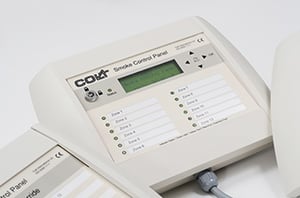Part 2 - Why are there more complex demands these days?
 The debate about the relative merits of open and closed control protocols is relatively recent. It has arisen because of the evolution of the smoke ventilation market towards more complex systems.
The debate about the relative merits of open and closed control protocols is relatively recent. It has arisen because of the evolution of the smoke ventilation market towards more complex systems.
Until the late 1990s, most smoke ventilation systems comprised large areas of natural vents which generally either all opened or all closed in zones. Controls were relatively simple. They were predominantly pneumatic and required a network of copper pipework, solenoid panels and a central compressor. Springs and fusible links on the ventilators provided a failsafe mode of operation.
More recently there has been an upsurge of large-scale residential schemes and commercial towers with fire-fighting shafts. These require smoke control systems that are capable of crossing fire compartments without compromising compartmentation and the fire resistant properties of walls and floors.
This means that, for example, if a fire occurs on one level in a multi-storey residential scheme, a damper needs to open on the fire floor to allow smoke to be vented to the outside. At the same time, dampers on all the other floors must remain closed to prevent smoke and fire spreading to other levels.
And the control sequence has a further level of complexity: once one floor has received an alarm and reacted, the system must then ‘lock out’ any other alarm signals. This is to stop multiple levels opening, which could allow smoke to spread from the floor of origin.
And there is more: the fire service needs the capability of a central override system to either instigate the system operation or cancel and re-assign the system operation.
Reducing complexity
All these different control sequences become much easier to control using a programmable operating system such as Colt OPV.
This conforms to the latest CE standards and provides a highly flexible and robust solution. It can be used to control all sorts of ventilators, dampers and fans in much the same way as a BMS, and can be linked to addressable smoke and heat detectors, call points and override devices.
Each addressable unit can be controlled individually and as part of the system, and up to 10 remote fire-fighter’s override panels can be included. And the system can be re-configured at any time if alterations are made to the scheme.
If you would like to know more about OPV, you can find more details here.
In my next blog post I will look at the key features that a smoke ventilation control system needs to have to help you make a decision on which path to follow in your selection.
Article 1: What are controls protocols?
Article 3: What the control system must deliver.
 Conor Logan is a Technical Manager of Colt UK, Smoke and Climate Control Division. Conor designs innovative smoke control and HVAC systems and is also Chairman of the Smoke Control Association.
Conor Logan is a Technical Manager of Colt UK, Smoke and Climate Control Division. Conor designs innovative smoke control and HVAC systems and is also Chairman of the Smoke Control Association.


